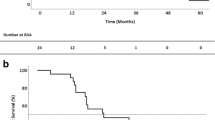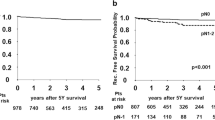Abstract
Background
Invasive mucinous adenocarcinoma (IMA) is distinct from non-mucinous adenocarcinoma, but studies on recurrent IMA are scarce. Thus, this study aimed to evaluate the recurrence patterns of IMA and the role of pulmonary local therapy (LT) in resectable pulmonary recurrence of IMA.
Methods
The study reviewed 403 patients with surgically resected IMA between 1998 and 2018. The recurrence patterns were categorized as solitary pulmonary recurrence (SPR), multiple pulmonary recurrence (MPR), and extra-pulmonary recurrence (EPR). The clinicopathologic characteristics, overall survival (OS), and post-recurrence survival (PRS) were analyzed according to the recurrence pattern and LT administration.
Results
Recurrences were found in 91 (22.6%) patients, including 18 patients with SPR, 37 patients with MPR, and 36 patients with EPR. Compared with the MPR and EPR groups, the SPR group had a longer disease-free interval (32.5 vs. 9.6 vs. 10.1 months, respectively; p < 0.01) and a better OS (5-year OS: 88.5%, 41.5%, and 22.9%, respectively; p < 0.01). In case of resectable pulmonary recurrence, pulmonary LT was administered to 15 patients with SPR and 3 patients with MPR. These patients showed a better 5-year PRS than the other patients with pulmonary recurrence (86.3% vs. 30.4%; p < 0.01). Notably, long-term survival was observed for one patient with MPR undergoing LT and two patients with SPR undergoing a second LT for a second pulmonary recurrence.
Conclusions
In this series, the patients with recurrent IMA showed different prognoses according to the recurrence pattern. The patients with pulmonary recurrence of IMA undergoing LT showed a favorable prognosis, suggesting the potential role of LT for resectable pulmonary recurrence of IMA.





Similar content being viewed by others
Abbreviations
- IMA:
-
Invasive mucinous adenocarcinoma
- KRAS:
-
Kirsten rat sarcoma virus
- LT:
-
Local therapy
- NSCLC:
-
Non-small cell lung cancer
- LVI:
-
Lymphovascular invasion
- VPI:
-
Visceral pleural invasion
- CT:
-
Computed tomography
- PRS:
-
Post-recurrence survival
- SPR:
-
Solitary pulmonary recurrence
- MPR:
-
Multiple pulmonary recurrence
- EPR:
-
Extra-pulmonary recurrence
- RT:
-
Radiation therapy
- OS:
-
Overall survival
- DFI:
-
Disease-free interval
References
Yoshizawa A, Motoi N, Riely GJ, et al. Impact of proposed IASLC/ATS/ERS classification of lung adenocarcinoma: prognostic subgroups and implications for further revision of staging based on analysis of 514 stage I cases. Mod Pathol. 2011;24:653–64.
Warth A, Muley T, Meister M, et al. The novel histologic International Association for the Study of Lung Cancer/American Thoracic Society/European Respiratory Society classification system of lung adenocarcinoma is a stage-independent predictor of survival. J Clin Oncol. 2012;30:1438–46.
Travis WD, Brambilla E, Noguchi M, et al. International Association for the Study of Lung Cancer/American Thoracic Society/European Respiratory Society international multidisciplinary classification of lung adenocarcinoma. J Thorac Oncol. 2011;6:244–85.
Borczuk AC. WHO classification of tumours: thoracic tumours. Lyon, France: International Agency for Research on Cancer; 2021.
Chang JC, Offin M, Falcon C, et al. Comprehensive molecular and clinicopathologic analysis of 200 pulmonary invasive mucinous adenocarcinomas identifies distinct characteristics of molecular subtypes. Clin Cancer Res. 2021;27:4066–76.
Shim HS, Kenudson M, Zheng Z, et al. Unique genetic and survival characteristics of invasive mucinous adenocarcinoma of the lung. J Thorac Oncol. 2015;10:1156–62.
Cha YJ, Kim HR, Lee HJ, Cho BC, Shim HS. Clinical course of stage IV invasive mucinous adenocarcinoma of the lung. Lung Cancer. 2016;102:82–8.
Cha YJ, Shim HS. Biology of invasive mucinous adenocarcinoma of the lung. Transl Lung Cancer Res. 2017;6:508–12.
Duruisseaux M, Antoine M, Rabbe N, et al. The impact of intracytoplasmic mucin in lung adenocarcinoma with pneumonic radiological presentation. Lung Cancer. 2014;83:334–40.
Wislez M, Massiani MA, Milleron B, et al. Clinical characteristics of pneumonic-type adenocarcinoma of the lung. Chest. 2003;123:1868–77.
Yang SR, Chang JC, Leduc C, et al. Invasive mucinous adenocarcinomas with spatially separate lung lesions: analysis of clonal relationship by comparative molecular profiling. J Thorac Oncol. 2021;16:1188–99.
Jasper K, Stiles B, McDonald F, Palma DA. Practical management of oligometastatic non-small cell lung cancer. J Clin Oncol. 2022;40(6):635–41.
Isbell JM, Li BT, Gomez DR. The emerging role of local therapy in oligometastatic non-small cell lung cancer. J Thorac Cardiovasc Surg. 2022;163:819–25.
Travis WD. The 2015 WHO classification of lung tumors. Pathologe. 2014;35(Suppl 2):188.
Gow C-H, Hsieh M-S, Liu Y-N, Lee Y-H, Shih J-Y. Clinicopathological features and survival outcomes of primary pulmonary invasive mucinous adenocarcinoma. Cancers. 2021;13:4103.
Hwang S, Han J, Choi M, Ahn MJ, Choi YS. Size of non-lepidic invasive pattern predicts recurrence in pulmonary mucinous adenocarcinoma: morphologic analysis of 188 resected cases with reappraisal of invasion criteria. J Pathol Transl Med. 2017;51:56–68.
Chang WC, Zhang YZ, Lim E, Nicholson AG. Prognostic impact of histopathologic features in pulmonary invasive mucinous adenocarcinomas. Am J Clin Pathol. 2020;154:88–102.
Sonoda D, Matsuura Y, Kondo Y, et al. A reasonable definition of oligo-recurrence in non-small cell lung cancer. Clin Lung Cancer. 2022;23:82–90.
Hishida T, Yoshida J, Aokage K, Nagai K, Tsuboi M. Postoperative oligo-recurrence of non-small cell lung cancer: clinical features and survival. Eur J Cardio-Thorac Surg. 2016;49:847–53.
Han SJ, Cho S, Yum S, Kim K, Jheon S. Surgical treatment of pulmonary oligorecurrence after curative resection for non-small cell lung cancer. Interactive CardioVasc Thorac Surg. 2020;30:18–23.
Goto T. Genomically metastatic, but surgically curable? J Thorac Oncol. 2022;17:e49-50.
Chang JC, Alex D, Bott M, et al. Comprehensive next-generation sequencing unambiguously distinguishes separate primary lung carcinomas from intrapulmonary metastases: comparison with standard histopathologic approach. Clin Cancer Res. 2019;25:7113–25.
Kim M, Hwang J, Kim KA, et al. Genomic characteristics of invasive mucinous adenocarcinoma of the lung with multiple pulmonary sites of involvement. Mod Pathol. 2022;35:202–9.
Author information
Authors and Affiliations
Corresponding author
Ethics declarations
Disclosure
The authors declare no potential conflict of interest. There is no source of any financial or material support..
Additional information
Publisher's Note
Springer Nature remains neutral with regard to jurisdictional claims in published maps and institutional affiliations.
Supplementary Information
Below is the link to the electronic supplementary material.
Rights and permissions
Springer Nature or its licensor (e.g. a society or other partner) holds exclusive rights to this article under a publishing agreement with the author(s) or other rightsholder(s); author self-archiving of the accepted manuscript version of this article is solely governed by the terms of such publishing agreement and applicable law.
About this article
Cite this article
Yoon, D.W., Hwang, S., Hong, T.H. et al. Distinct Recurrence Pattern and Survival Outcomes of Invasive Mucinous Adenocarcinoma of the Lung: The Potential Role of Local Therapy in Intrapulmonary Spread. Ann Surg Oncol 31, 201–212 (2024). https://doi.org/10.1245/s10434-023-14373-8
Received:
Accepted:
Published:
Issue Date:
DOI: https://doi.org/10.1245/s10434-023-14373-8




